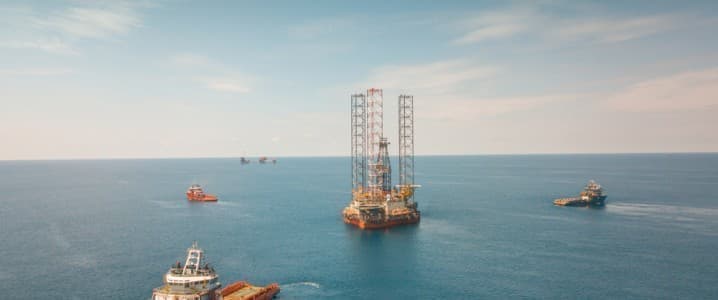Oil tumbled at the end of the U.S. summer driving season, with fears of an economic slump in China weighing heavily on the outlook for petroleum. As such, the international Brent benchmark plunged by over 12% in a month to lows not seen since early 2022, although in the wake of rising Middle East tensions, it has rebounded to be down 4% over that period. This forced the OPEC+ consortium to delay plans to hike production until December 2024. It is speculated that steadily rising non-OPEC global supply will cap any recovery, with Guyana’s impoverished South American country recently emerging as a major international oil producer and exporter. The former British colony, long ignored by Big Oil, will not only become South America’s top oil producer but a key driver of world petroleum supply growth.
After decades of poor drilling results, Guyana has rapidly emerged as a significant global petroleum producer following a series of world-class discoveries made by an Exxon-led consortium in the offshore 6.6 million acre Stabroek Block. The block, where Exxon is the operator holding a 45% working interest with partners Hess and CNOOC controlling 30% and 25%, respectively, is situated in Guyana’s territorial waters adjacent to the Essequibo region disputed by Venezuela. Since 2015, Exxon has made nearly 40 discoveries that are believed to contain at least 11 billion barrels of oil. The first discovery occurred in 2015 with the Liza-1 wildcat well, followed by the January 2017 Payara and Liza Deep discoveries, with the Liza 3 appraisal well found a 100 to 150-million-barrel reservoir below the existing Liza oilfield. It is speculated that the Stabroek Block contains well over 11 billion barrels of oil reserves, with the acreage possessing the potential to eclipse Brazil’s proven and probable reserves totaling 23 billion barrels, the second largest in South America.
The Liza Phase One project commenced operations in December 2019 with the start-up of the Liza Destiny floating production, storage and offloading (FPSO) vessel which can lift 120,000 barrels per day. Then, during February 2022, the Liza Phase 2 project was completed with the 220,000-barrel Liza Unity FPSO vessel commencing operations. By the end of November 2023, the Payara project was completed, with the 220,000 barrel-per-day Prosperity FPSO starting operations. This expanded the Stabroek Block’s capacity to 560,000 barrels per day. After enhancements, those facilities, since January 2024, have been pumping over 600,000 barrels per day. These developments, completed at a scorching pace, underscore that the Stabroek Block is a trillion-dollar opportunity for Exxon, its partners and Guyana.
In a stunning development, it took a mere four years for Guyana to go from the first discovery, made in 2015 with Exxon’s Liza-1 exploration well, to the first oil in 2019. This is incredible because it usually takes a decade or longer for development of billion-dollar offshore energy projects. Indeed, industry data shows it takes, on average, seven years for an oilfield to reach production, with at least a quarter of projects taking even longer to achieve first oil. Deepwater offshore fields, depths of over 4,000 feet or 1,219 meters, like those developed in Guyana and Suriname, are among the most difficult and slowest to develop. The pitfalls of deepwater development are apparent from Suriname’s Block 58. Despite TotalEnergies and APA Corporation making the first discovery with the Maka Central-1 wildcat well in January 2020, the multi-billion-dollar final investment decision (FID) was delayed, with first oil not expected until 2028, over eight years later.
In August 2024, Guyana’s Minister of Natural Resources, Vickram Bharrat, announced that the country’s oil reserves had grown by 600 million barrels to 11.6 billion barrels. This occurred because of Exxon’s latest oil discoveries in the prolific Stabroek Block. As a result, the South American country of less than one million now possesses the continent’s third largest oil reserves behind Brazil, which has proven reserves of around 16 billion barrels and Venezuela, with 303 billion barrels, the world’s largest. This abundance of high-quality discoveries in the Stabroek Block indicates that the Guyana Suriname Basin’s petroleum potential far exceeds the volumes calculated by the U.S. Geological Survey (USGS). The U.S. government agency determined the basin holds up to 33 billion barrels of crude oil, yet recent discoveries point to the basin’s true petroleum potential being significantly greater.
Foreign energy companies, notably Big Oil, invest tremendous amounts of capital in exploration and development activities in offshore Guyana. Aside from Exxon’s stunning exploration success in the Stabroek Block, a key attraction is the high-quality crude being found. The oil in the Liza oil field has medium density and is sweet, with Exxon’s assay showing an API gravity of 31.9 degrees and 0.59% sulfur. Those are crucial characteristics in a world where strict emission standards make it costly and complex to refine heavier sourer crude oils into low-emission fuels. Petroleum discovered in offshore Guyana outside of the Stabroek Block possesses similar qualities. One of the most important discoveries was with the Wei-1 wildcat well in the northern section of the Corentyne Block. The oil found was medium grade and sweet, but according to the operator CGX Energy, the reservoir qualities are analogous to those of the Liza-1 discovery.
As Guyana’s energy investment inflows rise and oil reserves grow, production in the tiny South American country will expand as more discoveries are made and new projects come online. Exxon is developing four projects in the Stabroek Block scheduled for completion between 2024 and 2029. The first is the multi-billion-dollar 250,000 barrel-per-day Yellowtail development, which is expected to come online by the end of 2025. This will be followed by the Uaru and Whiptail projects, with both possessing the capacity to lift 250,000 barrels per day, which will start up in 2026 and 2027, respectively. The final facility under construction is the Hammerhead project, which is expected to start lifting petroleum in 2029, adding 180,000 barrels per day to production in the Stabroek Block. Those facilities will add 930,000 barrels per day to Guyana’s oil production, lifting output to around 1.5 million barrels daily by the end of the decade.
Exxon recently completed work on the Liza Destiny and Liza Unity FPSOs, which began on 2 July 2024. This interrupted production in the Stabroek Block, causing it to plummet to around 500,000 barrels per day by the end of July 2024, significantly less than the 663,000 barrels per day lifted a month earlier. Exxon statements indicate both FPSOs are now pumping at capacity, with output returning to June 2024 levels of around 660,000 barrels daily. This work occurred to complete pipeline tie-ins for a gas-to-energy project, which will commence operation by the end of 2024. It will bring associated gas produced by the Liza FPSOs to shore via pipeline, for processing at a government-sponsored facility on the west bank of the Demerara River. The commercialized gas will fire a 300-megawatt powerplant to generate electricity, which Georgetown asserts will reduce local electricity costs by up to 50%.
For these reasons, the U.S. Energy Information Administration (EIA) stated Guyana has emerged as a critical contributor to global petroleum supply growth. In its short-term energy outlook, the U.S. government agency predicts the former British colony will be lifting 865,000 barrels of crude oil daily by November 2025. This will make Guyana the second largest oil producer in South America, behind Brazil, while ranking the country 20th globally, ahead of Colombia and Oman. The impoverished South American country’s rapidly expanding output makes it the third fastest growing non-OPEC oil producer globally, behind the U.S. in first place and Brazil second, making it an essential contributor to world petroleum supply.
Nonetheless, fears emerged that a dispute between Exxon and Chevron would impact the development of the prolific Stabroek Block. Houston-based Exxon, the operator holding a 45% interest in the Stabroek Block, and partner CNOCC claim Chevron’s $53 billion acquisition of Hess triggered the first right of refusal to sell the takeover target’s 30% share of the block. As such, both supermajors are now locked in arbitration, where Exxon argues that the takeover represents a change of control, activating its right of first refusal. The Houston-based supermajor has flagged that it may bid for Hess’s share of the Stabroek Block if victorious, but it won’t acquire the company. This is a blow for Chevron because analysts estimate the value of Hess’ stake in the Stabroek Block comprises up to 80% of the $53 billion bid. Chevron argues there is no change of ownership because Hess will remain intact and become a subsidiary if the takeover, which Hess’s stockholders approved proceeds.
By Matthew Smith for Oilprice.com
More Top Reads From Oilprice.com
Source link : http://www.bing.com/news/apiclick.aspx?ref=FexRss&aid=&tid=66f1e16379c14bf196d18673492d891e&url=https%3A%2F%2Foilprice.com%2FEnergy%2FCrude-Oil%2FFrom-Rags-to-Riches-Guyanas-Meteoric-Rise-as-a-Petrostate.html&c=7194615361706844402&mkt=en-us
Author :
Publish date : 2024-09-23 10:00:00
Copyright for syndicated content belongs to the linked Source.







